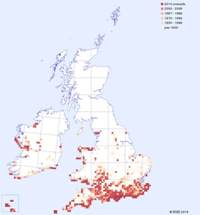As its name suggests, Autumn Lady's-tresses is the last of our British orchids to flower each year and typically appears at the end of August and the beginning of September. This orchid grows in short-sward, lime-rich grassland, often close to the coast. In a good year thousands of flowers can appear, but if the grass is cut or grazed too often Autumn Lady's-tresses can fail to flower, perhaps saving itself for more favourable conditions. Spiranthes spiralis also colonises some lawns and gardens where the grass is kept short, but it will only thrive in locations where it does not have to compete with other taller plants. Two similar species are found in Britain: Creeping Lady's-tresses Goodyera repens and Irish Lady's-tresses Spiranthes romanzoffiana. The latter was, until recently, thought to be confined to scattered locations in Scotland, Ireland and Northern Ireland and to have become extinct in England. However in Wales, where it had never been recorded, Spiranthes romanzoffiana appeared in 2019 in Dyfi National Nature Reserve, near Borth. Spiranthes spiralis, in contrast, is found in southern England, Wales and Ireland. In England its most northerly known site is in Yorkshshire. On mainland Europe this orchid occurs from Scandinavia in the north to as far south as the Mediterranean Region.
| Distribution Map | Key Features | |
 |
Records for Autumn Lady's-tresses from BSBI are shown on the map with most recent in front. (Hover the mouse over the small map to expand it.) |
Plant: 3 to 20cm in height; stem pale green and densely hairy towards the tip. |
Image Gallery for Autumn Lady's-tresses Spiranthes spiralis
| Pollination | Taxonomy & Hybrids |
The flowers are pollinated by bumblebees, which are rewarded with nectar. |
The specific name spiralis means twisted and refers to the flowers, which coil tightly around the stem of the inflorescence. |
Articles about Autumn Lady's-tresses in JHOS
